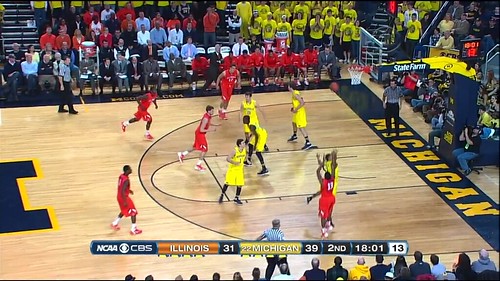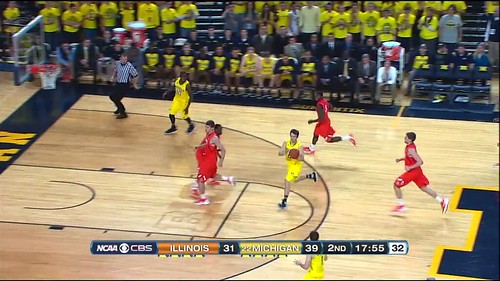secondary break
In his recap of the Illinois game, Brian left a bit of a hint about what I should take a look at when watching film this week:
Michigan got a ton of fast break and secondary transition points; in the second half when Illinois was crashing the boards hard anything that didn't end up getting rebounded by the trees fell to a shorter faster Michigan player and the resulting transition opportunity was often an odd-man break. I'd be interested to see a breakdown of Illinios points off of offensive rebounds versus points in transition when Michigan actually got the board. I'd guess it would be a small advantage to Illinois, but not one that outweighs the benefits of going small to Michigan's halfcourt offense.
You know Brian; he puts the 'b' in subtle. Somehow managing to pick up on this, I took a look through the film at each of Illinois's missed shots, recording the result of the miss (offensive or defensive rebound), points scored off those misses, and how often a Wolverine rebound resulted in a fast or secondary break. Brian's assessment was pretty darn accurate.
Illinois second-chance points: 9
Michigan transition points directly following a defensive rebound: 9
The Illini, like Brian stated, went all-out on the offensive glass, coming up with 14 offensive boards (although two of those were "team rebounds" when Michigan knocked the ball out of bounds). I counted 18 defensive rebounds for the Wolverines—the box score shows one more; I think that came in the waning seconds—and had this breakdown of what they did with them:
Fast break: 4 opportunities, 4 points.
Secondary break: 5 opportunities, 5 points.
Michigan slowed pace and went into their half-court offense on the other nine rebounds; as you can see, half the time they were running after a miss. Here's a closer look at how Michigan pushed the pace off a miss. In this first frame, you see Illinois putting up an outside shot while the Wolverine have four players in good position to get a rebound:
Illinois ends up with three players either inside or directly next to the paint as Evan Smotrycz grabs the board. Before Smotrycz even hits the ground, everyone but Burke is charging up the court. Burke starts to flash to the middle of the floor in case Smotrycz needs an outlet:
Smotrycz turns and takes one dribble. This snapshot is taken right before he passes to Novak, whose feet you can see at the very top of the screen. Hardaway is already well down the floor, and Michigan has the numbers to run:
Novak gets the pass on the wing and heads to the middle of the floor, drawing in the Illini defense. Douglass trails and is wide open as Illinois is late to figure out matchups and making sure that Hardaway—who's behind the defense—is accounted for:
Douglass gets a wide-open look for three, though his shot draws iron. Still, Michigan is able to create a great look from distance by recognizing Illinois's aggressiveness on the offensive glass and countering. Full video of the play:
Douglass actually ended up with a second open look on the secondary break later in the half. On this particular play Michigan is really able to go full-bore as it's Burke who comes down with the rebound, enabling the other four players to head up the floor without worrying about who's going to handle the ball in the backcourt. Burke drives hard into the paint, catching Illinois off-guard and freeing up Douglass for a shot from the exact same spot as earlier. Unfortunately, he misses again, but it's still a nice play by Burke to create the shot:
In case you're feeling the need to complain about Stu—unwarranted, in my opinion, as he hit two of his other three shots while playing phenomenal defense on Brandon Paul (7 TOs)—here he is taking it coast-to-coast for a layup when he sees an opening in the Illini D:
While Michigan once again was dominated on the glass in their own end, they largely negated this advantage for Illinois by making them pay for crashing the boards. With Ohio State—a team that thoroughly destroyed the Wolverines in the rebounding category in their first matchup—next up on the schedule, Michigan will need to continue exploiting these openings created when the Buckeyes get too aggressive offensively.




7